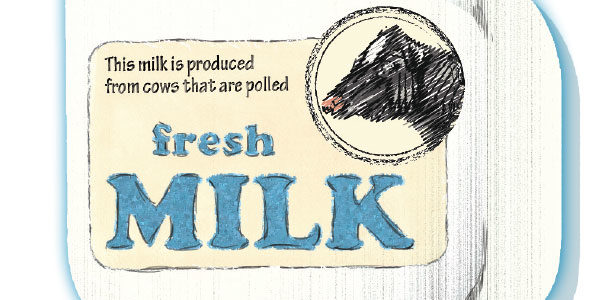Today, almost all packaged fluid milk, as well as many other dairy products sold to consumers, has the following or something similar printed on the product’s package: “This milk is produced from cows not treated with artificial growth hormone or BGH.”
Labeling of fluid milk from cows not treated with BGH or rbST began in earnest about 10 years ago. Fluid milk consumers told grocery stores and fluid milk processors they did not want to drink milk from cows treated with artificial hormones.
Grocers and processors listened to their customers and responded accordingly. If dairy farmers wanted to keep shipping milk to these plants, they complied, and some plants paid a premium for milk from cows not treated with rbST, which provided an added incentive for dairy farmers to comply.
During this period of time, many – especially on the production side of the dairy industry – worked hard to stop the consumer movement against rbST. Scientific material documenting the safety of rbST and its benefits was distributed.
Even though millions of dollars were spent promoting rbST, at the end of the day, the consumer was heard and the industry responded. A consumer call that began in a few markets rapidly spread throughout the country.
Will the next consumer call be that milk must be from cows that are polled? Will processors require their milk supply to only come from polled cows? Will we see dairy product labels stating, “This milk is produced from cows that are polled.” I do not know for sure if this will happen, or if it does, when. But based on consumer trends and the growing interest in animal welfare, it is a distinct possibility.
Consumers continue to show greater interest in how food is produced. One only needs to look at the growth of the organic food industry to see this trend. Organic food sales have tripled over the past decade.
Consumers want food from animals treated humanely. Grocery stores carry eggs marketed from cage-free chickens. There are laws in some states, initiated by various consumer groups, prohibiting the use of gestation crates for sows and requiring chickens to have a minimum amount of space.
Major food companies, including Walmart, the nation’s largest grocer, have animal welfare policies. Walmart’s policy includes the globally recognized five freedoms of animal welfare: freedom from hunger and thirst; freedom from discomfort; freedom from pain, injury or disease; freedom to express normal behavior; and freedom from fear and distress.
Suppliers to these companies are asked to implement practices consistent with these animal welfare freedoms. Some think dehorning must be banned to comply with the animal freedoms.
General Mills, who claims they are the first yogurt (Yoplait) company to source milk from cows not treated with rbST, supports the use of polled genetics to eliminate the need of dehorning. Dunkin Brands (doughnuts and restaurants) also includes the use of polled genetics to eliminate dehorning as part of its animal welfare policy.
In addition, Dunkin has set 2022 as the year to serve only gestation crate-free pork. Plus, Dunkin is moving to only serving eggs from cage-free hens. By the end of 2016, Dunkin expects at least 10 percent of its eggs will come from cage-free layers. Look for more food companies to implement similar policies, including encouraging polled cattle.
To the best of my knowledge, so far, food companies are only encouraging, not requiring, the use of polled genetics. Having been on the front line of the rbST debate, what starts out as “encouraging” by grocers and processors can easily lead to “requiring.” History shows successful, profitable consumer companies listen and respond to their customers.
Consumers may have a different perception or understanding of the facts compared to those in production agriculture. However, if a company wants to stay in business and make money, they provide what their customers say they want. Consumers are the ones buying the products and spending the money.
Yes, the arguments can be made that dairy farmers humanely de-bud or dehorn their animals. Plus, there are third-party verification programs now in place to audit such practices. We can argue that requiring dairy farmers to only used polled genetics can limit or slow genetic progress in increasing milk production, which could increase milk production costs.
And this could decrease the milk supply, thus increasing consumer costs of dairy products. Similar types of arguments are made about rbST. However, in the end, consumer perception and their understanding of the facts almost always wins.
We live in a country with an abundance of food. How often do you see empty grocery store shelves in the U.S.? For most people, it is never. U.S. consumers spend a relatively small portion of their income on food.
As long as consumers have the “luxury” of abundant, quality, varietal and relatively inexpensive food, it is difficult to change their perceptions of how food should be produced and food animals treated. No matter how sound and fact-based the arguments. It will take empty grocery shelves and consumers spending the bulk of their income on food in order to convince them otherwise. And I for one hope we never see empty shelves.
As mentioned earlier, I was on the front line during the rbST debate. The cooperative in which I served as the CEO lost millions of dollars in fluid milk sales because it was slow to react to the consumer demand for milk from cows not treated with rbST. I remain convinced the entire dairy industry is still suffering from lost fluid milk sales because it dragged its feet on appropriately responding to this consumer demand.
Will milk only from cows that are polled become a requirement by some or all milk processors? Time will tell for sure, but current trends point in that direction. The good news is that the availability of polled genetics is growing. And with today’s improved genetic tools, the number of polled genetic bulls can be expanded more quickly compared to earlier years.
Regardless of the issue, be it polled or something else, the dairy industry must constantly listen to and be close to the consumer. The need to listen and be close to the consumer is even greater today. This is due to increased competition for a share of the consumer’s stomach from dairy-like products and the growing number of people who advocate an end to consuming any food from animals, including dairy.
The industry must react quickly and responsively to consumer demands to keep and grow its market share. If the consumer does not buy that gallon of milk, chunk of cheese or carton of ice cream, there is no commercial dairy industry. We must never forget it is the consumer of dairy products that keeps us all in business. PD
Calvin Covington is a retired dairy cooperative CEO and now does some farming, consulting, writing and public speaking.

-
Calvin Covington
- Retired Dairy Cooperative CEO
- Email Calvin Covington





